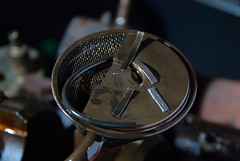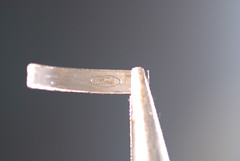I got the engine out of the Caddy this weekend! The first lesson I learned is that I should have either removed all of the pulleys and water pump, or removed the front clip of the car. I had a TON of trouble getting the motor out past the radiator core support! In fact, I wound up yanking the water pump off while the motor was in limbo just to buy myself a few more inches of clearance.
Once it was finally out, and safely on an engine stand, I started my investigation and search for the source of my “clunk” sound. First, I yanked the intake manifold and the cover for the lifter valley. I found nothing particularly interesting there, certainly no obvious foreign object which would account for the noise I’ve been hearing. So, I tipped the thing over and started pulling out oil pan bolts and upon removing the pan I was greeted with what you see on the left.
First, I yanked the intake manifold and the cover for the lifter valley. I found nothing particularly interesting there, certainly no obvious foreign object which would account for the noise I’ve been hearing. So, I tipped the thing over and started pulling out oil pan bolts and upon removing the pan I was greeted with what you see on the left. Now I expected to find chunks of oil dipstick in the engine, since I’d previously reported that the dipstick appeared broken. What I did not expect though was that the dipstick would be so completely mismatched! The photo on the right shows the engraving of “Ford” on the dipstick. Apparently the previous owner just decided to toss whatever dipstick he had handy into the tube, and call it a day.
Now I expected to find chunks of oil dipstick in the engine, since I’d previously reported that the dipstick appeared broken. What I did not expect though was that the dipstick would be so completely mismatched! The photo on the right shows the engraving of “Ford” on the dipstick. Apparently the previous owner just decided to toss whatever dipstick he had handy into the tube, and call it a day.
Not knowing what the original design of the Cadillac dipstick is, I can’t be sure, but it feels like this is a bit of a poor design. If the dipstick is straight, and goes down the dipstick tube straight, it appears as though it’ll run right smack dab into the rotating assembly as you can see on the left.
If the dipstick is straight, and goes down the dipstick tube straight, it appears as though it’ll run right smack dab into the rotating assembly as you can see on the left.
As satisfied as I was with my discovery, I realized pretty quickly that this couldn’t be the source of the “clunk” I was chasing down. The bits of dipstick were simply too small and light weight to account for the sound I was experiencing. Plus, when I pulled the oil pan off, all of the bits were sitting right inside the oil pickup which means they were likely “stuck” there by suction from the oil pump any time the engine was running. So I kept inspecting, looking for any other foreign object big enough to account for what I’d heard.
After several minutes of looking around with a flashlight, I figured I’d start turning the motor and seeing if anything seemed out of place. I pulled all the plugs so that compression wasn’t an issue, and started turning the motor over. It turned nice and easy until it neared top dead center (TDC), where it halted and I couldn’t seem to continue turning it no matter how much (reasonable) force I applied. Perplexed, I went ahead and turned the engine the opposite direction. Again it turned smoothly until I had reached a full rotation in the opposite direction and it again stopped dead in it’s tracks. Hrrmnnn..
So that’s the current mystery, the engine doesn’t seem to turn over freely any more now that I’ve pulled it out, and turned it upside down! I knew it couldn’t be piston to valve contact, since it’s a hydraulic lifter motor and almost all of the lifters had lost pressure allowing all the valves to stay closed. So, more likely it’s piston to head contact. I didn’t notice any obvious signs of bent connecting rods or loose connecting rod caps so the cause isn’t readily apparent. Next step will be to yank the heads off and see if there is any obvious damage which might indicate which cylinder is causing the problem. The title to this post may be a bit premature, but I don’t suspect I’m going to find anything minor. Stay tuned as I continue to tear it down to find the problem!
